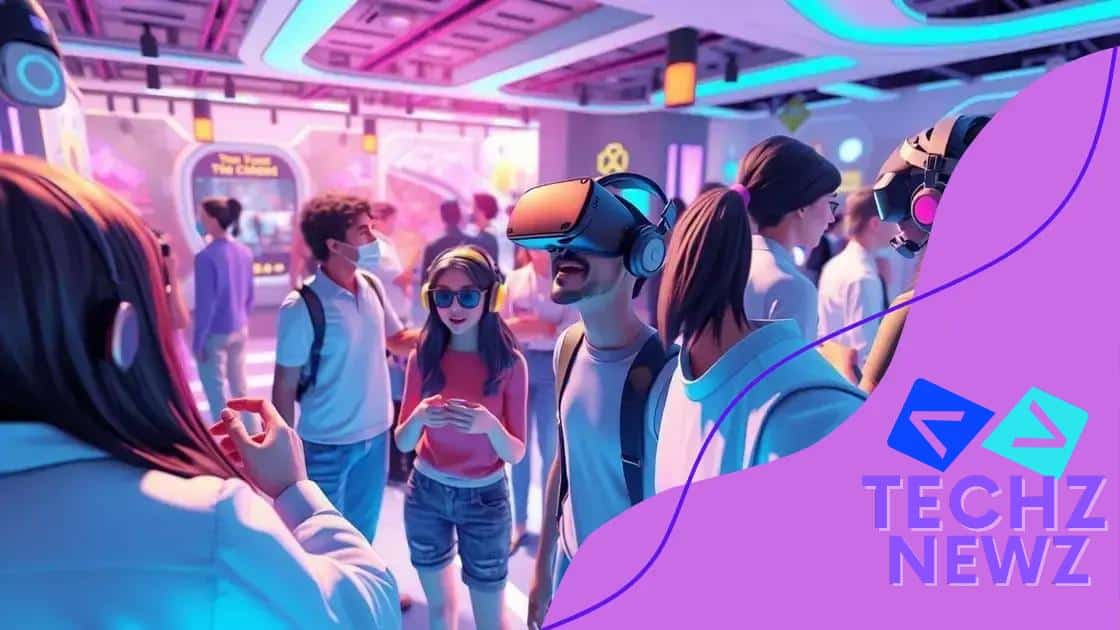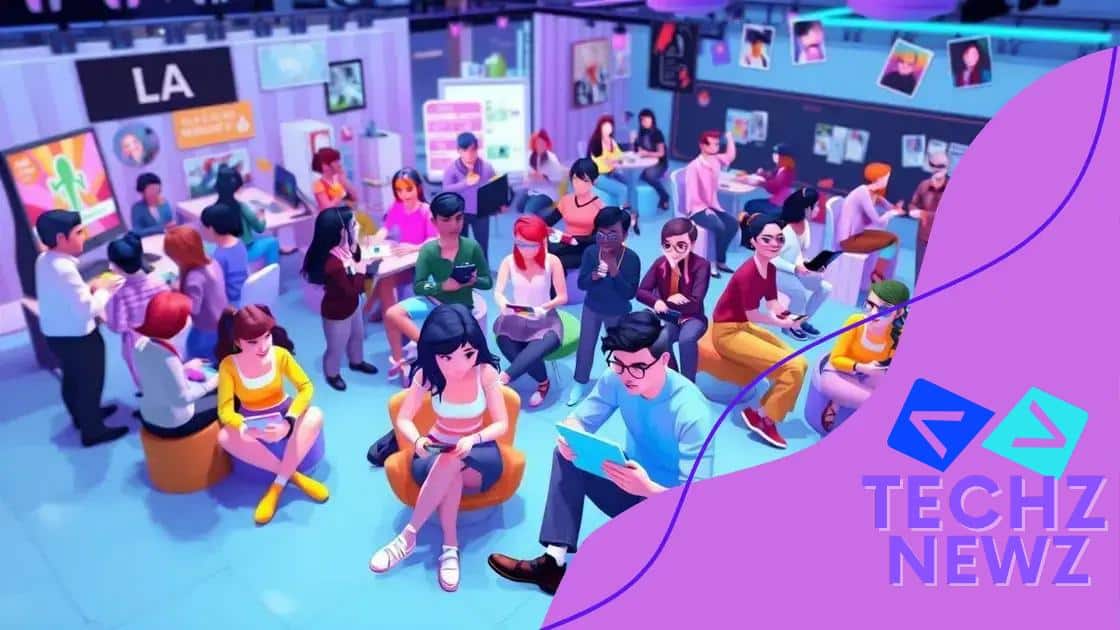Metaverse in reshaping the online social experience

The metaverse is transforming online social experiences by providing immersive environments for users to interact, communicate, and build communities through personalized avatars and innovative platforms.
Metaverse in reshaping the online social experience offers exciting new ways to connect with others. Have you ever imagined hanging out with friends in virtual worlds? This article will guide you through this immersive digital realm.
Understanding the metaverse concept
The metaverse is an evolving concept that represents a collective virtual space. It merges physical and digital worlds, creating immersive environments where users can interact, socialize, and conduct business.
To better understand this concept, let’s dive into its key characteristics and how it impacts our daily lives.
Key Features of the Metaverse
Several features define the metaverse. These elements work together to create a comprehensive user experience that is both engaging and interactive.
- Virtual Reality (VR): Integrates realistic environments, allowing users to experience sensations similar to real life.
- Augmented Reality (AR): Enhances the physical world by overlaying digital information, creating a blend of both worlds.
- Interoperability: Facilitates seamless interaction between different platforms and experiences, enabling cross-platform engagement.
- User-Generated Content: Empowers individuals to create and share their own digital assets, fostering community building.
These features enhance user engagement and create unique interactions that were once unimaginable. As technology advances, the possibilities within the metaverse expand, allowing for richer experiences.
The metaverse not only influences gaming but also transforms social interactions. Imagine attending a concert in a virtual venue, interacting with friends from across the globe. These experiences shift our understanding of social events, making them more inclusive and accessible.
Impact on Society
The societal impact of the metaverse is profound. It changes how we communicate and socialize, especially in today’s digital age. For many, it provides a sense of belonging and community, vital for mental well-being.
As we embrace this shift, we need to consider the implications for future generations who may grow up in this interconnected digital world. How will their interactions differ from ours? Will virtual relationships hold the same weight?
In summary, the metaverse offers intriguing opportunities that bridge the gap between digital and physical interactions. Understanding this evolution will be crucial as we navigate our shifting social landscapes.
Impact on online communication
The impact on online communication within the metaverse is significant. As we embrace these new virtual spaces, the way we interact changes dramatically. Conversations take place in environments that feel more engaging and immersive than traditional messaging.
Imagine chatting with friends in a virtual café instead of a text box. This shift corresponds to a more natural and interactive experience.
Enhanced Interactions
In the metaverse, interactions become multi-dimensional. Users can convey emotions through avatars, using facial expressions and gestures as they communicate. This creates a much richer dialogue.
- Expressiveness: Avatars can mimic real-life body language, allowing for deeper connections.
- Shared Spaces: Meeting in virtual worlds creates experiences where users feel physically present, fostering collaboration.
- Immersive Experiences: Engaging in shared activities, like playing games or attending events together, enhances the social aspect.
- Real-Time Collaboration: The metaverse enables groups to work together, overcoming geographical barriers.
This new form of communication also requires a shift in understanding social cues. In virtual environments, reading body language is essential, and users may adapt their styles accordingly. Understanding these dynamics is crucial for effective communication.
Another crucial aspect is how the metaverse allows for diverse voices to emerge. Users from different backgrounds can interact, share perspectives, and learn from each other, enriching the overall experience. As we grow accustomed to this style of communication, new norms will likely arise.
Challenges of Virtual Communication
While the experience is exciting, there are challenges. Misinterpretations can happen without physical context. Additionally, not everyone may feel comfortable navigating these virtual spaces, creating potential barriers to communication.
The impact on online communication in the metaverse illustrates how technology continues to reshape our interactions. As we explore this digital frontier, understanding its nuances will be key to using it effectively and embracing its potential.
Social interactions in virtual environments

Social interactions in virtual environments have transformed the way we connect with others. These immersive spaces allow users to engage in more dynamic and interactive ways than traditional online platforms.
In virtual settings, people can meet, share experiences, and collaborate regardless of their physical location, creating a sense of presence that enhances social connections.
Types of Interactions
There are several types of interactions that occur in these environments, each offering unique opportunities for connection.
- Text-based Communication: Users chat in real-time through text, making discussions accessible and immediate.
- Voice Communication: Many virtual environments support voice chat, allowing for more personal conversations that mimic in-person dialogue.
- Non-verbal Communication: Users express themselves through gestures and avatar movements, adding layers of meaning to interactions.
- Group Activities: Engaging in virtual events or games provides shared experiences, fostering teamwork and friendship.
This variety of interactions enriches social experiences and helps build communities. The ability to communicate through multiple tools makes it easier for users to find their preferred ways to interact. Social presence becomes more pronounced as individuals engage with one another, leading to deeper relationships.
Moreover, virtual environments provide safe spaces for people to express themselves. They can be a refuge for those who may feel shy or uncomfortable in physical settings. This openness cultivates creativity and invites diverse perspectives into conversations.
Building Connections
As users navigate these spaces, they share parts of their lives and interests, forming bonds based on commonalities. Friendships may bloom from shared gaming experiences, attending virtual concerts, or collaborating on projects.
In addition, virtual environments break down geographical barriers. Individuals from all over the world can come together to discuss ideas, share cultures, and collaborate on innovations, creating a rich tapestry of social interaction.
As we explore social interactions in virtual environments, it becomes clear that they offer innovative ways to connect. While challenges exist, such as maintaining authentic connections, the potential for meaningful relationships continues to grow in these digital spaces.
Emerging platforms for socializing
Emerging platforms for socializing in the metaverse are reshaping how we connect with others. New technologies are constantly evolving, creating innovative spaces that allow users to interact, share experiences, and form communities.
These platforms offer exciting opportunities for various activities, from casual meetups to more structured events. Understanding these options will help users find the best fit for their social needs.
Popular Emerging Platforms
Several notable platforms are gaining traction in the realm of virtual socializing. Each brings unique features that enhance user experience.
- Horizons Worlds: A Facebook Meta creation that allows users to build and explore together in a vibrant virtual community.
- VRChat: A platform where users can create their own worlds, customize avatars, and socialize with others in immersive environments.
- Rec Room: A game-like space where players can hang out with friends, play games, and create content.
- Second Life: An established platform where users live a second life and engage in various activities, including shopping, attending events, and even working.
These platforms foster social interactions by encouraging creativity and collaboration. Users can join different events, participate in user-generated content, and experience social dynamics in ways that are often unavailable in traditional social media.
The experience becomes more enjoyable as users navigate these environments. Many platforms emphasize community-building features, such as clubs, groups, and events, making it easier to connect with like-minded individuals.
Features Enhancing Connection
Certain features make these platforms appealing for socializing. From customization options to interactive activities, users can engage more deeply than through standard messaging or video calls.
- Customization: Users can design their avatars and spaces, allowing for personal expression.
- Interactive Events: Many platforms host concerts, meetups, and games, creating engaging ways to connect.
- Cross-Platform Access: Some platforms can be accessed through VR devices or standard screens, ensuring accessibility for everyone.
- Community Focus: Groups and clubs help users find common interests, fostering deeper connections within communities.
As emerging platforms for socializing develop, they create new ways to interact and share online. The potential for connection and community is vast, making these spaces exciting for users seeking more than just text or photos. Exploring these platforms can lead to valuable relationships and enjoyable experiences in the expanding metaverse.
Future trends in digital social life
Future trends in digital social life are continuously evolving as technology advances. As the metaverse expands, new social patterns and interactions are emerging.
People are increasingly seeking immersive experiences that blend the digital and physical worlds, leading to more genuine connections online.
Increased Customization
One of the notable trends is the growth of customization options for users. As platforms continue to develop, individuals will have more freedom to create their virtual identities.
- Avatar Personalization: Users can design their avatars with unique styles, allowing for better self-expression.
- Customized Spaces: Individuals will create and modify their personal virtual environments to reflect their tastes and preferences.
- Enhanced Community Features: New tools will allow users to form tighter-knit communities based on shared interests and activities.
- Unique Events: Virtual events that cater specifically to community preferences will become popular, fostering stronger connections.
As customization becomes more prominent, users can build identities and connect more meaningfully with others who share similar passions.
Integration of AI and Machine Learning
Another significant trend is the integration of AI and machine learning into social platforms. These technologies will enhance user experience in various ways.
- Smart Recommendations: Algorithms will suggest friends or groups based on common interests, making connections smoother.
- Personalized Content: AI will curate content feeds tailored to individual preferences, ensuring users encounter relevant and engaging material.
- Enhanced Communication Tools: AI-driven translation services will break language barriers, allowing global communication.
- Virtual Assistants: Intelligent assistants will provide users with guidance on navigating platforms and optimizing their social experiences.
The integration of these technologies can help users navigate the vast digital landscape while facilitating connections across cultures.
Increased Focus on Mental Health
With the rise of digital social life, mental health awareness will be paramount. Users are becoming more mindful of their well-being in virtual environments.
Future platforms may incorporate features that promote balance and mental wellness, such as:
- Mindfulness Tools: Built-in options to take breaks or engage in relaxation exercises while using the platform.
- Community Support Spaces: Virtual areas where users can seek help or guidance regarding mental health issues.
- Positive Engagement Metrics: Tracking and encouraging positive interactions to create a supportive environment.
- Resources and Information: Access to mental health resources will be integrated into social platforms.
As digital experiences evolve, the focus on mental health will shape how users connect and interact in these environments.
Future trends in digital social life will be driven by innovation and user feedback, creating exciting opportunities for connection. Understanding these shifts will allow us to adapt and make the most of our digital interactions in the metaverse.
FAQ – Frequently Asked Questions about the Metaverse and Digital Social Life
What is the metaverse?
The metaverse is a collective virtual space where users can interact, socialize, and engage in immersive experiences blending the physical and digital worlds.
How do emerging platforms enhance social interactions?
Emerging platforms provide more personalized and immersive ways to connect, allowing users to engage through unique avatars, customized spaces, and interactive activities.
What role does AI play in future social platforms?
AI enhances user experience by providing smart recommendations, personalized content, and communication tools that break down language barriers.
How can users maintain mental wellness in virtual spaces?
Users can find support through community spaces, mindfulness tools, and resources integrated into platforms that promote balanced and positive engagements.





